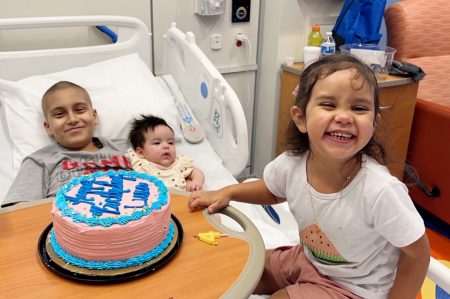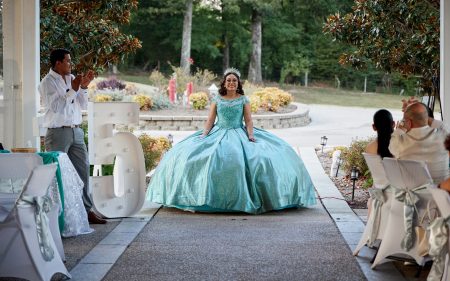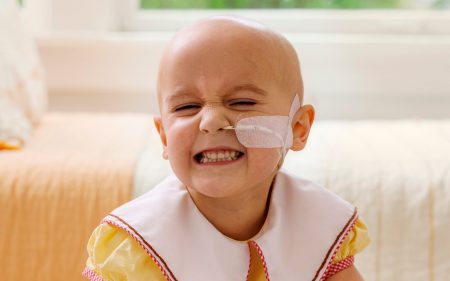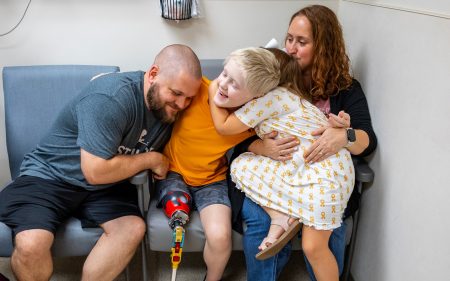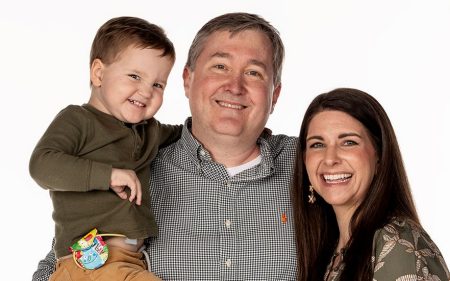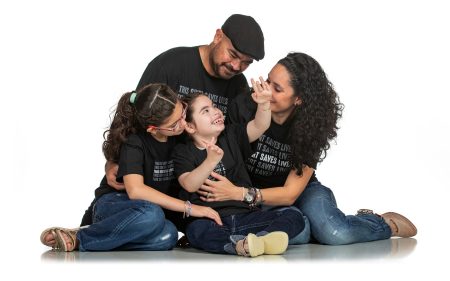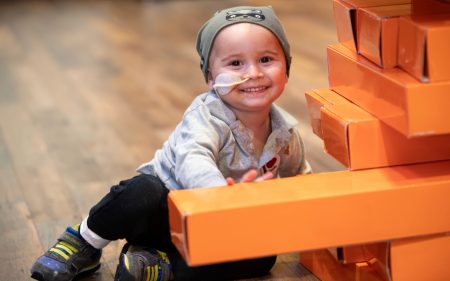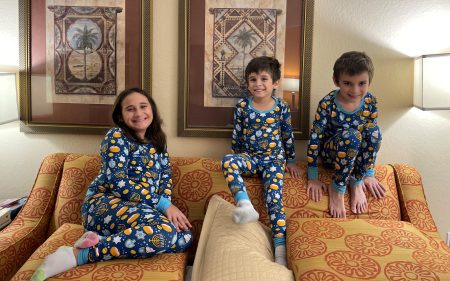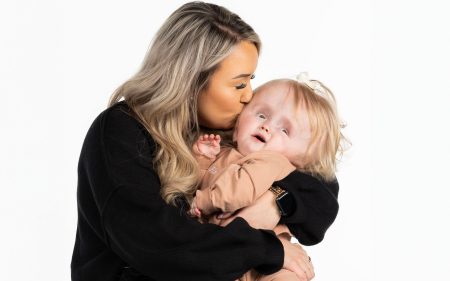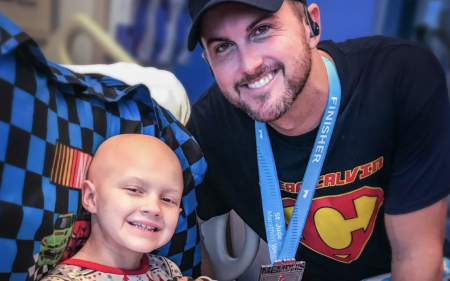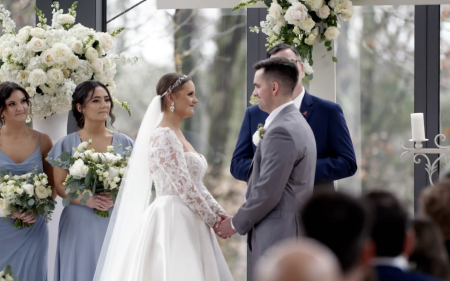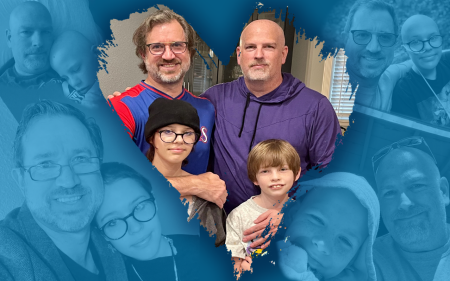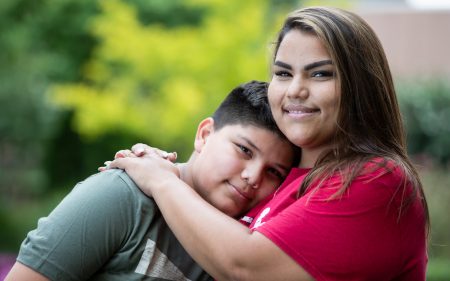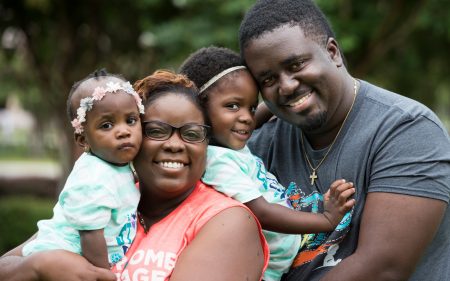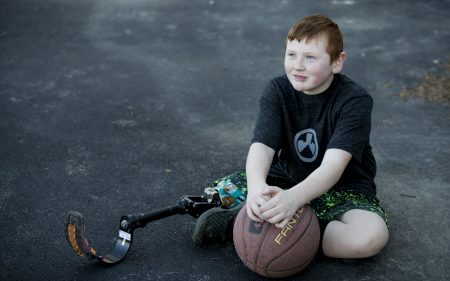
Diagnosis is just the start of the journey for patients and families navigating catastrophic illnesses. They’ll need courage, hope, strength and an indomitable spirit, but the caregivers of St. Jude are with them every step of the way. With this series, you can follow along.
STORIES
-
St. Jude patient Avalyn survived leukemia. Now the 11-year-old budding writer and actor takes the stage for her second act
Her parents believed cancer would be one part of a much longer story.
-
Childhood cancer hijacked our holidays and changed us forever
We are reclaiming hope and joy while Maizy receives treatment at St. Jude.
-
The hope they gave helped save their daughter
Moved by stories of kids with cancer, Brittany and Matt became monthly donors — Partners in Hope® — to St. Jude Children’s Research Hospital. They never imagined they would need it.
-
Luis Martin celebrates Christmas and New Year’s with family and reflects on cancer treatment at St. Jude.
Grateful for the care that helped him heal, Luis Martin is embracing the joy of togetherness.
-
Held together by love and hope
Jeritza came to St. Jude in search of treatment — and found so much more. Today, she remains connected to the community that embraced her during her journey.
-
Twirls, dresses and dancing: A toddler’s journey through cancer at St. Jude
Cailee is facing childhood cancer with pink and an unbreakable spirit.
-
Dakota’s journey from St. Jude cancer treatment to Division I golf is a triumph years in the making
A solid plan, steady support and his own relentless drive bring a long-awaited goal to life.
-
‘Faith, courage and strength’ helped Luis Carlos through cancer treatment at St. Jude
Luis Carlos relied on the support of his loved ones, along with their family motto, to get through cancer treatment at St. Jude.
-
A quinceañera to remember for Aylin amidst cancer treatment at St. Jude
Surrounded by family, friends and hope, Aylin’s milestone birthday was filled with unforgettable moments.
-
A grandmother’s journey: supporting my grandson through brain tumor treatment
Finding peace in the lifesaving work of St. Jude
-
Despair to healing: How Valentina found lifesaving care 2,500 miles from home
At St. Jude, Valentina began a journey of hope and recovery far from everything familiar.
-
Cancer is a chapter in Olivia’s life, but it’s not the full story
It’s a part of her, but it doesn’t define her,’ says mom Fanisha
-
Teen cancer survivor raises funds through the St. Jude Walk
Sebastian is giving back to St. Jude and has made it his mission to help other children facing cancer.
-
St. Jude families find community through art in anticipation of Sickle Cell Awareness Month
Patients of all ages, and their siblings, let their creativity flow and talk about what makes them feel strong.
-
At St. Jude, Sully’s family found world-class medical care and unexpected joy
“We’re united by one thing: We want our kids to be happy,” said Sully’s mom.
-
St. Jude patient Braylan faced cancer like a superhero
Facing cancer, 6-year-old found strength in his favorite superheroes — and the real ones at St. Jude Children’s Research Hospital®.
-
Mateo and his family found healing and renewed hope at St. Jude
Now in treatment, Mateo’s cancer journey is filled with progress and possibilities.
-
Ukrainian girl celebrates milestone at St. Jude
Separated from her homeland by conflict, Diana found care, comfort and a path forward at St. Jude.
-
St. Jude patient Gideon taking big steps on cancer journey
He gave away thousands of toy cars to kids at St. Jude. Now, the teenage cancer survivor is stepping into the spotlight and planning a trip across America — on foot.
-
Watch: After cancer treatment, St. Jude patient Reid turns 18 and readies himself for college
Reid and family reflect on past days of chemotherapy and MRIs, and look toward the next chapter of their lives
-
Making every precious moment count
Phenix’s family celebrates life’s special moments thanks to St. Jude.
-
Bailey lives active life with sickle cell disease
St. Jude improves quality of life for young sickle cell patients with use of medicine that reduces life threatening symptoms of the disease.
-
Bravery in braids: How a crocheted hat helped St. Jude patient Kinsley heal
When chemotherapy caused Kinsley’s hair to fall out, her mom crocheted her a hat with long brown yarn braids. Turns out it had magical powers.
-
Watch: Patient Yike embraces joy and community with patients and care team at St. Jude
Yike has gone through chemotherapy and a bone marrow transplant for acute myeloid leukemia (AML).
-
Caps, gowns and elation: St. Jude hosts heartwarming kindergarten graduation
For St. Jude patients like Eri'Elle, Caleb and Yara, kindergarten graduation is an extra special milestone.
-
St. Jude patient Romeo's father reflects on his son's brain tumor diagnosis and treatment
Romeo has returned to school and his dad is cherishing every moment together.
-
Often dressed like her St. Jude doctor, Maizy faces leukemia with strength beyond her years
St. Jude is healing Maizy as Maizy heals her family.
-
My son Josiah, a St. Jude patient, has persevered through cancer and more
The child who seems a little different may be the strongest person you’ll ever meet.
-
A mother pays tribute to her daughter Bertha and thanks St. Jude
Gemima always remembers her daughter and continues to learn from her.
-
Pennsylvania girl’s unsteady steps lead to brain cancer diagnosis
After treatment at St. Jude, Emery is back to her bubbly, cheery self.
-
Ben’s return: From St. Jude brain cancer treatment to tennis court comeback
After pausing tennis for treatment at St. Jude, Ben is back on the court and using his experience to help others.
-
St. Jude patient Natalie is a big sister for the first time
Her mom wasn’t sure how Natalie would handle a new sibling. She was the family’s baby and doted on during her cancer treatment at St. Jude.
-
St. Jude patient Cooper’s sea turtle artwork shimmers with life on Carnival Cruise Line ship
Carnival celebrates the creativity and spirit of all St. Jude kids.
-
Valentina's resolve and joy
The family of this St. Jude patient treasures every moment by her side.
-
How St. Jude patient Camila’s cancer fight inspired her sibling’s military journey
Camila's courage motivated her sister Alexandra to complete basic combat training.
-
Women who Inspire: Dr. Julie R. Park
She leads a team of St. Jude doctors and researchers working to ‘get cures faster for kids with cancer’
-
Leading With Laughter
Despite losing his leg to cancer, Hunter's spirit shines as he learns to walk again and embraces life with humor.
-
Video: Amy reflects on her family legacy and son James' cancer treatment
James was diagnosed with neuroblastoma at 3 months old, and relapsed at 3 years old.
-
Mischief and hope: St. Jude patient Miguel’s journey through cancer
St. Jude patient Miguel’s mom cherishes his playful spirit, even as he faces his second cancer diagnosis and treatment.
-
For Vietnam’s dad, St. Jude ‘is a very special place’
Vietnam's story: From a rare brain tumor diagnosis at age 6 to a high school student, thanks to St. Jude Children's Research Hospital.
-
Honoring Three Kings Day
María Antonieta and Javier's Tennessee home becomes a haven of anticipation for the Three Kings' visit, filling their daughters' stockings with joy.
-
First Christmas memories made at St. Jude
María Fernanda's Christmas preparations start early. From wish lists to family traditions, discover her journey from Cuba to St. Jude and beyond.
-
New Year, new joy: St. Jude families ring in the new year with their favorite traditions.
St. Jude patients Luis Martin, Lizzie and Romeo eagerly await New Year's.
-
Given a second chance at life, St. Jude patient Reid makes the most of every moment
At 7, he was treated for cancer at St. Jude Children’s Research Hospital®. Now 17, he’s inspiring others with his approach to life.
-
For St. Jude patient Ashtyn, little moments in life embody big hope
She was treated at St. Jude Children’s Research Hospital for a cancerous brain tumor at 5. Now 11, she’s enjoying all the moments her moms were scared she wouldn’t get.
-
In the hallways of St. Jude, Griffin’s mom realizes no family fights cancer alone
When Jen was weary, questioning whether she could take one more step, the walls of St. Jude Children’s Research Hospital® urged her on.
-
Elani’s custom cookies are her family’s newest Christmas tradition
St. Jude patient cherishes special moments with family during the holidays.
-
Kindness brings light to St. Jude patient Griffin’s Hanukkah family tradition
During Hanukkah, Griffin's family found hope and community at St. Jude, lighting the menorah despite cancer's challenges. A story of resilience and faith.
-
St. Jude families united in gratitude
Lucas and his family celebrate Erntedankfest with gratitude and a special meal, honoring his health journey and the spirit of Thanksgiving.
-
"I have become a better human being thanks to St. Jude"
Victoria, 17, finds inspiration in butterflies, reflecting her journey from a brain tumor diagnosis through treatment St. Jude Children’s Research Hospital.
-
For St. Jude patient Beckett’s family, Thanksgiving recipe adds up to gratitude for life
After Beckett was treated for brain cancer at St. Jude Children’s Research Hospital, his family doesn’t take anything for granted.
-
This Diwali, St. Jude is ‘a blessing’ for Aditya
Aditya, a 4-year-old diagnosed with acute myeloid leukemia, finds hope and treatment at St. Jude Children's Research Hospital after a difficult journey.
-
St. Jude supporter Arsh Pal embraces Diwali with acts of kindness
In Chicago, Arsh Pal’s home shines bright for Diwali, celebrating light over darkness. Arsh, a St. Jude supporter, sells his paintings to help kids with cancer
-
In decorating for Halloween, Josiah’s family celebrates his survival and his joy.
Ever since Josiah survived rhabdomyosarcoma, every holiday is precious. This Halloween, the family is giving back to St. Jude.
-
St. Jude patient and his father go through cancer journey together
Antonio's best friend is his dad, Sebastián. Their bond grew stronger as Sebastián became his bone marrow donor during Antonio's battle with acute myeloid leukemia.
-
Pepe's special quinceañera dance
Pepe, a cancer survivor treated at St. Jude, plays a key role in his sister Joana's quinceañera in Tennessee, celebrating family, tradition, and resilience.
-
From heartbreak to joy: A grandmother recounts granddaughter’s treatment at St. Jude
Traci witnessed her blessings first-hand through her granddaughter Fletcher.
-
Kindergarten Adventures Begin for St. Jude patient Yara
Yara, a spirited 5-year-old, starts kindergarten with excitement. Diagnosed with SAMD9L syndrome, she receives treatment at St. Jude Children's Research Hospital.
-
Lifelong friends share greatest challenge with cancer diagnosis for cousins Logan and McClain
Lifelong friends Anna Marie and Christine, now St. Jude moms, support each other as their daughters battle neuroblastoma. Their bond is unbreakable.
-
St. Jude patient Bridget turned her shyness into strength
Bridget, 6, returned home from St. Jude to a heartwarming welcome with a limousine and hundreds of cheering neighbors.
-
St. Jude patient Brayden has tackled cancer twice with quiet bravery.
Read about Brayden's brave journey battling medulloblastoma twice with the support of St. Jude Children's Research Hospital.
-
‘Blessed and enjoying every precious day with my son’
When our 8-year-old son Nate was diagnosed with a cancerous brain tumor, our lives changed instantly. Thanks to St. Jude Children's Research Hospital, we received life-saving treatment without financial burden. Five years later, Nate is thriving. We are forever grateful for the support and care from St. Jude.
-
Watch: St. Jude patient Mila faced leukemia treatment with smiles to spare.
"St. Jude has given us a lot of hope," said her mom.
-
Delta was determined to get to her dad at St. Jude. Millions cheered her on.
Watch Delta's heartwarming reunion with her dad at St. Jude go viral, capturing the hearts of millions as she battles leukemia.
-
Yarianis' triumph over adversity, one day at a time
Follow Yarianis' inspiring journey overcoming bone cancer with the help of St. Jude Children's Research Hospital's cutting-edge treatments.
-
Daughter and mom celebrate graduation together at St. Jude
The milestones of life still happen, even for families at St. Jude. In fact, celebrations are often that much sweeter.
-
When my son, Chance, was diagnosed with a cancerous brain tumor, St. Jude offered a way forward.
St. Jude gave us our Chance, literally and figuratively.
-
This family has supported St. Jude for generations. They never dreamed they were paying it forward.
James is receiving cancer treatment at St. Jude for the second time.
-
St. Jude patient offers her own balloon art to everyone she meets
Misheel is a brave 11-year-old battling cancer at St. Jude Children's Research Hospital. With her balloon creations, she spreads happiness among her peers, crafting whimsical animals, flowers, and the occasional Ninja Turtle.
-
Embracing Mother’s Day with hope and a grateful heart
Celebrate Mother’s Day with us as we share our journey of hope and resilience in the face of childhood cancer. Join us in cherishing every moment with St. Jude Children’s Research Hospital.
-
Women Who Inspire: Surekha Murti-Fehr
Surekha Murti-Fehr's inspiring journey from battling acute lymphoblastic leukemia at St. Jude to becoming a dedicated lymphedema therapist for breast cancer patients.
-
Celebrating the qualities of motherhood on Mother’s Day
St. Jude moms are emblematic of mothers everywhere. When needed, they meet the moment with strength, care and thousands of other characteristics that make a mom a mom.
-
The long journey back to normal
Acute lymphoblastic leukemia (ALL) put Sydney on the sidelines. After two-and-a-half years of treatment, he’s working to “get back to normal.”
-
St. Jude patient’s cheer section included University of Alabama women’s softball team
Alyson and Duke are childhood friends bonded by sports. Follow their journey as they rally around Duke's sick daughter, Madelyn, and witness the power of love and support.
-
Homecoming triumph: Emma defeats eye cancer and returns home to her 'Magical Town' in Mexico
Emma's story: From a magical town to a brave fight against eye cancer. Join her family's journey of strength and determination.
-
Women Who Inspire: Maggie Cupit-Link, MD
Witness Maggie Cupit-Link's unwavering commitment to making a difference in the lives of children and her inspiring story of resilience and hope.
-
Women who Inspire: Somer Greene
Somer Greene, a cancer survivor, founded Teens on the Scene charity to help inner-city children. Her inspiring story of resilience and giving back.
-
Teen Kiki and her pal, service dog Asher, navigate life after cancer treatment
Kiki was diagnosed with a brain stem tumor at age ten. Her long journey has led her to where she is now, managing her health and wellbeing with the help of her family, service dog and St. Jude.
-
A Mother’s Gratitude
Celebrate Jordyn's journey from battling leukemia to becoming a champion gymnast and track athlete. Join us in honoring her resilience and success..
-
Women who Inspire: Gabby Salinas
Gabby Salinas, a living example of perseverance, overcame cancer three times and continues to seize every opportunity. Learn about her inspiring journey here.
-
Women who Inspire: Kris Keys
Dive into the world of Kris Keys, a talented artist who transformed her battle with a genetic blood disorder into a source of creativity and beauty. Follow her journey of overcoming challenges and finding strength in art and nature.
-
Women Who Inspire: Hayley Arceneaux
Not even the sky is the limit for Hayley Arceneaux . For St. Jude patient, physician assistant and astronaut, life is a big adventure.
-
Women Who Inspire: Ana Duran
Ana Duran's fearless spirit led her to create Curious Bike Tours, a business born out of passion and determination. Follow her journey from cancer survivor to successful entrepreneur.
-
Women Who Inspire: Angelique C. Graham Harlan
Explore the touching narrative of Angelique C. Graham Harlan, a dedicated nurse whose career was shaped by her personal battle with cancer and the unwavering support she received from St. Jude Children’s Research Hospital.
-
Women Who Inspire: Emily Hoskins
Emily was born paralyzed from the waist down, her spine severed by neuroblastoma tumors. At 3 days old, she traveled with her father from Illinois to Tennessee, having received a referral to St. Jude Children’s Research Hospital.
-
Women Who Inspire: Addie Pratt
In 2016 she was diagnosed with acute myeloid leukemia. The high school freshman was referred to St. Jude and was in treatment for six months. Today, she is cancer-free.
-
Women Who Inspire: Kate Foster
A competitive gymnast, training 20 hours weekly, Kate tried to reckon having to give up the sport. She’d started at 7 and loved it. But then her coach called: “I’ve never taught a one-legged gymnast before, but I’m willing to try if you are.” She gave Kate hope.
-
Women Who Inspire: Mary Browder
Mary Browder learned at age 10, when she was being treated for Hodgkin lymphoma at St. Jude Children’s Research Hospital, that she shouldn’t let the circumstances she is faced with define her.
-
With individualized care at St. Jude, Elani is ready for the world
Discover how St. Jude Children’s Research Hospital® is transforming the lives of sickle cell disease patients like Elani with cutting-edge treatments and care.
-
Our daughter taught us about life
Experience the profound impact of childhood cancer on a teacher's family. Follow their emotional journey as they find strength, support, and life-changing treatments at St. Jude Children's Research Hospital.
-
Her sister was a St. Jude patient, and now her son is, too
Uncover the Story of Jessica and Her Family's Connection to St. Jude - From Tragedy to Triumph.
-
Hope for saving Ava
Follow Lakesha's emotional rollercoaster as she grapples with her daughter's neuroblastoma diagnosis and the heartbreaking reality of limited treatment options in their country.
-
Natalie got a second chance – and then a third – at St. Jude
Experience the overwhelming whirlwind of emotions as Nicole's family deals with a fractured arm, a potential cancer diagnosis, and the unexpected support from loved ones during their ordeal.
-
‘Tangible Sense of Hope’
Uncover the remarkable healing journey of two little girls who overcame brain tumors with the help of St. Jude Children's Research Hospital, where cutting-edge treatments and compassionate care make a difference.
-
After 11 months of treatment, Emma remains cancer-free
These first-time parents thought they were losing their baby to brain cancer. St. Jude gave them hope.
-
Twins are inseparable after one is treated for brain cancer at St. Jude
Janelle is learning to walk again and is encouraged by her sister, Amalia.
-
St. Jude patient Beckett reunited with family in time for Thanksgiving
Experience the comforting chaos of a family who values togetherness above all else, and follow the heartwarming journey of Beckett and his siblings in a surprise reunion.
-
Embracing memories: St. Jude families remember their children on Día de los Muertos
The celebration allows families to display mementos and their child’s favorite foods on special altars.
-
Embracing life amid loss
After two cancer diagnoses and a third scare, St. Jude offered compassionate care for the Brumfield family.
-
Even cancer couldn’t change St. Jude patient’s inner spirit
Arearn's youngest child, Kenadie, brings laughter and joy as she confidently claims to be her mother's favorite. Despite facing health challenges, Kenadie's spirit remains strong, and she continues to defy cancer with the support of St. Jude Children's Research Hospital®.
-
Excitement and jitters replace treatment and IVs as new school year starts for Mayela
Read about Mayela's journey from battling leukemia at St. Jude to starting sixth grade with excitement and a bit of nervousness.
-
Childhood leukemia survivor prepares to pursue a medical career, wants to give back
Juan Sebastian, who ranks third in his graduating class, has been accepted to the Universidad de los Andes in Bogotá, where he will study medicine.
-
Treated for a brain tumor, Jean Pierre heads to Penn State University
As he prepares to move out of the country for college, he said he feels well prepared for the challenges ahead.
-
As Lauren navigates college, she wants the world to know she's more than 'the girl who had cancer'
Days after a surgery that removed the grapefruit-sized tumor wrapped around her lower spine, Lauren was walking around St. Jude Research Hospital in Memphis.
-
With St. Jude on his team, Emmanuel worked hard and kept the faith on the football field
Emmanuel was diagnosed with retinoblastoma, a cancer of the eye, in 2008 when he was 4 years old.
-
St. Jude patient Olivia named 2023 FedEx 'Purple Eagle' honoree
FedEx names a plane in honor of a 7-year-old St. Jude patient at the FedEx St. Jude Championship.
-
The Power of Hope
How 4-year-old Lucas never lost faith in the healing power of St. Jude.
-
Nothing in her experience as a mom of five prepared Nicole for childhood cancer. But St. Jude offered hope.
For most of 18 months, Nicole and her daughter Natalie have made St. Jude their home while Natalie receives treatment for neuroblastoma.
-
‘My child has cancer’
Mother’s online diary chronicles Rinoa’s treatment at St. Jude
-
What a mother’s love will do for patient of St. Jude
From the moment Megan saw the photograph from the adoption agency, she knew she would do anything for her new daughter — including help save her life.
-
St. Jude helped Adrienne find the art in life
St. Jude patient Adrienne reflects on her cancer journey and path to a career in creativity.
-
After saying ‘I do’, husband says thank you to St. Jude supporters
St. Jude Children’s Research Hospital gave Parker’s wife, Allie, a second chance at life.
-
Journey to motherhood full of grief, loss and joy
As a childhood cancer survivor, St. Jude has been woven into Jessica’s entire life. Now, it’s woven into her daughter’s as well.
-
Five years after completing neuroblastoma treatment at St. Jude, Lucas dreams of a life by the sea
The boy from Chile returned to the research hospital for a medical check-up — a crucial moment for him and his family.
-
It’s not about the cards, candy or flowers — ‘He is my gift’
For Mother’s Day, St. Jude mom Erika celebrates all the little moments with her son after treatment
-
Bella is dad’s heart, his ‘everything’
After diagnosis of a brain tumor, this family came to St. Jude where ‘the darkness entirely vanished.’ Now, dad cherishes every moment with his daughter.
-
Mom & daughter: a cancer journey taken hand-in-hand
St. Jude Children’s Research Hospital helped this family survive life’s darkest moments to arrive at the most joyous of occasions.
-
St. Jude and Monster Jam put a smile on Calvin’s face
After a cancer diagnosis, this St. Jude patient found hope and light through art while in treatment.
-
‘The world just stopped’ with brain tumor diagnosis
From the day their lives ‘changed forever,’ Sasha’s parents counted on St. Jude for their daughter’s mental and physical well-being.
-
St. Jude patient shares her story with First Lady Jill Biden
Katherin acknowledges that talking about her cancer journey has become a personal mission that motivates her to give her best every day.
-
More than 10 years after a cancer diagnosis, an independent St. Jude patient is ready to ‘fly’
Kayla’s mom worried a cancer diagnosis and treatment that followed would change the person her daughter was meant to be.
-
After relapse, Luna finds hope and healing at St. Jude Children’s Research Hospital
Cancer journey gives dad a new perspective and big dreams for his daughter and the mission of St. Jude to end childhood cancer everywhere.
-
A big football player gets chance to see little boy with cancer all grown up
Pro Football Hall of Famer Howie Long first met Owen when he was 5 and in treatment at St. Jude Children’s Research Hospital.
-
Thanks to St. Jude research, Carrie celebrates life, looks forward to parenthood
A protocol developed at St. Jude made it possible for Carrie to be treated at her local hospital. Today, she works in support of St. Jude, “the best humanity has to offer.”
-
Newfound hope for Kamryn
Kindergartner Kamryn is thriving thanks to advances in research and treatment pioneered at St. Jude Children's Research Hospital.
-
Dad reflects on challenges of childhood cancer, burden lifted by St. Jude
When Calvin was diagnosed with cancer, his family’s whole world was ‘flipped upside down.’ St. Jude Children’s Research Hospital provided a sense of calm.
-
Tina's 15th birthday, a celebration of life after a brain tumor
Coming to St. Jude and meeting her doctor, we stopped being afraid." This teen's family remembers her experience with cancer while celebrating her birthday in style.
-
From surviving to thriving after pediatric cancer
St. Jude patient Allie builds a new life and a home on love and gratitude
-
Born with sickle cell disease, Za’Mya thrives in care of St. Jude Children's Research Hospital
Mom credits St. Jude for the life her daughter is able to lead and includes its supporters among her family and village.
-
Twelve years after first undergoing treatment at St. Jude for brain cancer, Ian enjoys life
His dad credits the St. Jude commitment to ongoing cancer research for saving Ian, adding, “From day one, we have never seen a bill.”
-
St. Jude patient takes her first steps for the second time
St. Jude mom cheers as Eri’Elle learns to walk again
-
This little girl celebrated beating cancer at St. Jude in an unusual way
Stella was 4 when she was diagnosed with a rare form of leukemia and treated at St. Jude Children’s Research Hospital. Now 10, she has big dreams for the future.
-
Felicity spent her very first Christmas in treatment at St. Jude. Today, she's growing up.
An aggressive brain tumor could have ended her life, but Felicity is thriving thanks to St. Jude.
-
Eri'Elle is always "ready for fun," despite intensive cancer treatment.
Once unable to walk due to a tumor, St. Jude patient Eri'Elle is all about play.
-
St. Jude keeps Eliza giggling
Mom and dad felt hopeless when their 4-month-old ‘ray of sunshine’ was diagnosed with retinoblastoma. St. Jude gave them hope and years of memories ahead.
-
Tina's quinceañera: a tradition of a lifetime
After overcoming a cancer diagnosis at age 10, this St. Jude patient and her family celebrated her 15th birthday in style.
-
Families rocked by cancer describe healing power of unity at St. Jude
“When you’re together, you can make things happen,” said Stephanie, a St. Jude parent.
-
Three-year-old takes her first steps after rhabdoid cancer treatment at St. Jude
"Thank God for St. Jude," her mother said.
-
Then & Now: David is healthy after defeating cancer with the help of St. Jude and his grandfather
David just celebrated his 14th birthday, a milestone his grandfather is certain would not have happened without the care and treatment of St. Jude Children’s Research Hospital.
-
St. Jude eye cancer survivor thriving on football field and in life
Emmanuel lost an eye to cancer - but never his vision for the future.
-
Reid’s St. Jude journey is a quilt of stories, lessons and triumphs
This family wasn’t planning for childhood cancer — no family does — but St. Jude was here for them and became their ‘saving grace.’
-
St. Jude kids shine on the world stage at FedEx St. Jude Championship
Will Zalatoris has first PGA TOUR win in a contest that provides enduring support for St. Jude.
-
FedEx St. Jude Championship: St. Jude brain cancer survivor excels at second shot
Ad airing during the PGA TOUR highlights Ian’s perseverance on course and in life.
-
St. Jude patient Riley honored as Purple Eagle patient
For this year’s FedEx St. Jude Championship, Riley will be honored as the Purple Eagle patient, a program in which a plane features the name of a child or grandchild of a FedEx team member.
-
FedEx St. Jude Championship: 18th hole marks end of emotional trek for St. Jude cancer survivor
For years, Will Patton's parents have been synching his yearly checkup visits to St. Jude Children’s Research Hospital with the PGA TOUR stop in Memphis.
-
Charlotte has changed her mother's life, and her outlook. 'She made me a mom,' and then 'a cancer mom.'
When 7-year-old Charlotte was diagnosed with medulloblastoma, her treatment plan at St. Jude was tailored to her particular subtype of medulloblastoma, giving her a second chance at life. Her mother, Barbara, tells their story.
-
Like son, like father: St. Jude dad hopes to be like cancer survivor son
As he gets ready to send his son, Pete, off to college, St. Jude dad Jeff is thankful for a life that almost never was.
-
St. Jude dads' bond forged through shared worry and hope
With their daughters in treatment, Dan and David relied on each other for support, found friendship through common experience.
-
New treatment offers hope for devastating brain tumor diagnosis for 6-year-old girl
Lizzie is back home in Texas going to school, participating in jiu-jitsu, and hoping to become a triathlete just like her older brother and sister.
-
St. Jude patient Kamryn shares big personality with the world
Melissa looks up to and admires her son, thanks St. Jude for giving her hope.
-
Karate set the foundation; St. Jude helped Zoe achieve her goals
After treatment for a brain tumor, Zoe’s determination and positive attitude led her to realize her dream of becoming a champion.
-
St. Jude cancer survivor Katherin takes no day for granted
Diagnosed with cancer at 19, Katherin made it through treatment thanks to her family, her faith and St. Jude.
-
Family emerges from ‘dark place’ of cancer diagnosis together, stronger thanks to St. Jude
Riku was treated for medulloblastoma, a brain tumor, at 3 years old. Today, this caring and kind boy is back home in Japan, playing soccer and attending school.
-
After treatment for leukemia at St. Jude, Luna looks to the stars
Luna aspires to be a doctor, teacher, physical therapist and now an astronaut, all careers inspired by her time at St. Jude Children's Research Hospital.
-
During treatment at St. Jude for kidney cancer, Bailey dreamed of what she'd be when she grew up
Now that she is done with treatment, Bailey has her sights set on a law career and being in the Marine Corps, just like her dad.
-
St. Jude mother, worried her son would be forgotten, realizes he left a legacy.
Amelia Salas lost one son to cancer. She’s counting on what St. Jude researchers and doctors are learning from genetic testing to save another.
-
St. Jude mother watches son go from crawling in pain because of cancer to running a half marathon
'All I could think of is that they had just saved my niece’s life... They’re gonna save his.'
-
As Elaina undergoes treatment for a second tumor, St. Jude is a constant
Six-year-old Elaina has a genetic condition that pre-disposes her to cancer throughout her life. For families like hers, St. Jude is a lifeline of continuing care.
-
Cancer treatment at St. Jude was lifesaving for Ava, life-changing for her family
After medulloblastoma treatment, fresh promise and new priorities.
-
First a St. Jude supporter through Best Buy, now a St. Jude dad
After visiting St. Jude Children's Research Hospital, Mark Lavoie learned: The family you’re helping may someday be your own.
-
A victory against cancer and a holiday celebration like no other
With their daughter back home, Marlene and Juan Manuel are looking forward to a Christmas filled with food, family and the giggles of little Mikayla.
-
Avyan got treatment at St. Jude while his parents got a 'huge relief mentally' from medical bills
"It’s a huge, huge blessing," says his mother. "It’s like a holy place for me.”
-
Avyan got treatment at St. Jude while his parents got a 'huge relief mentally' from medical bills
"It’s a huge, huge blessing," says his mother. "It’s like a holy place for me.”
-
St. Jude cancer survivor shines in international paraclimbing competitions
After treatment for Ewing sarcoma, Micah discovered a love of climbing and a path to an identity beyond his battle with cancer.
-
Immunocompromised during COVID-19, Luxe came to St. Jude for a cure
Luxe had a failing immune system as the COVID-19 pandemic swept the world. St. Jude helped heal her and kept her safe.
-
Jace sets the pace after cancer as an infant
The treatment team at St. Jude made sure Jace's future mobility remained a priority.
-
St. Jude patient Kenzie honored as FedEx 'Purple Eagle' patient
After being treated at St. Jude for acute lymphoblastic leukemia, Kenzie is 'a normal teenager' looking forward to a future helping other cancer patients.
-
Caring, compassionate Colton lost a kidney to cancer, but never lost heart
Throughout treatment at St. Jude, Colton focused on his concern for others. Now, he says, 'I can be a kid again.'
-
Teen cancer patient 'competes' against her disease at St. Jude
Marayah's goal is to beat cancer then play college soccer.
-
Possibilities: Mayela
Kid entrepreneur Mayela brings verve to her time at St. Jude as her family finds relief during her leukemia treatment
-
Hayley Arceneaux’s St. Jude journey: From cancer patient to astronaut
Hayley Arceneaux was treated at St. Jude for osteosarcoma. Now, she’s going to represent the research hospital in space. This is her St. Jude journey.
-
Military family finds community of care for 2-year old at St. Jude
Griffin's family has lived all over the world, and found a new meaning for home while he was receiving treatment for leukemia
-
Hazel is colorful, creative and cancer-free after treatment at St. Jude
St. Jude's science helped Hazel overcome leukemia; her art celebrates the journey.
-
St. Jude making progress to subdue sickle cell disease
New advances have increased the life-expectancy for patients born with the blood disorder, and researchers now are driving toward cure.
-
Caleb's 'spectacular' podcast of hope
Longtime St. Jude patient hopes to inspire others, especially those with special needs, to persevere and achieve goals.
-
St. Jude Inspire Sports: Jake's Take on the NFL draft, with guest Fletcher
Jake interviews Fletcher about his love for the Cleveland Browns, connection with Jarvis Landry and the impact of St. Jude
-
From Syria to St. Jude, a refugee recounts a harrowing journey to save his son
In desperation, Hussam knocked on every door he could think of after his son was diagnosed with eye cancer, and found help in an unlikely place.
-
Aspen's family finds kindness, joy at St. Jude
During treatment for cancer, Aspen still has time for play
-
Take a tour of brain tumor survivor Evan’s favorite places at St. Jude
Evan found community and “a home” during his brain tumor treatment in 2019.
-
Elliott favors fun over fear during cancer treatment
When he was diagnosed with leukemia, St. Jude made a tumultuous time easier for the whole family
-
Active and nature-loving Alexander receives specialized treatment for brain cancer
At 7 years old, Alexander brings joy to all at St. Jude
-
Even cancer didn't dim Azalea's 'sunny' spirit when she was diagnosed as a 2 year old
Her parents laud St. Jude for helping them reclaim the life and family they so cherish
-
When he lost his right eye to cancer, Ty drew and baked for comfort, but also to help St. Jude
Ty's creativity has raised thousands and helps him connect with others to support St. Jude.
-
'Spicy' St. Jude patient rebounds from leukemia
Mom is encouraged by Eleanor's unwavering spirit
-
She had to learn to walk again after cancer surgery. Now Caitlin Adkins is an athlete and inspiration.
CrossFit community gives childhood cancer survivor and St. Jude a 'lift'.
-
Through past and present, the Spence family holds strong ties with St. Jude
Robert Spence found a sense of mission and equality at St. Jude. Decades later, his niece found life-saving treatment, and his son, a career.
-
Faith defines Selah's St. Jude journey
A family pulls together through the unimaginable
-
St. Jude Inspire Sports: Jake's Take on the big game
Jake is back to talk about everything from his favorite team's success to the best snack for watching an important football game
-
From doubt to success: How Azalea's parents found the beginning of great things at St. Jude
When Simone and Ricardo's daughter was diagnosed with cancer in Jamaica, the odds seemed insurmountable. Then a call from St. Jude changed it all.
-
St. Jude patient Faith lives up to her name
She brought a can-do attitude to even the hardest days of cancer treatment.
-
Three patients, three protocols: Making progress through cancer research
The stories of Brian, Caleb and Mason highlight the progress St. Jude continues to make in treating ALL, the most common form of childhood cancer.
-
St. Jude patient Smyrna becomes a Cook to Follow on Allrecipes
She teaches us how to make a pineapple cake, and why pineapple might be the most inspiring fruit of all.
-
Allrecipes names St. Jude patient Reed a 'Cook to Follow'
Follow along as he makes his favorite deep dish pizza.
-
From minister to medical, Ryan takes a journey of faith
Ryan Pattat was diagnosed with a brain tumor at 7 years old. His story, and his faith, have inspired others.
-
St. Jude Inspire Sports: Jake's Take with special guest, Oni
Jake and St. Jude teen patient Oni talk Seahawks v. Bills, brain cancer treatment and recovery
-
A tale of Christmas past
Each year, Kaylee's family remembers the journey that brought them where they are today.
-
The kid with the magic smile
Cameron 's positive approach to cancer treatment encouraged everyone around him.
-
No place like home
A cancerous brain tumor separated Aubree from her family, but only temporarily.
-
A grandfather's legacy of cancer research gives his grandson hope
Dr. Charles Pratt spent decades researching pediatric cancer at St. Jude. Now, his family is getting hope from the hospital where he made his life's work.
-
The love of a madrina lifts up cancer patient at St. Jude
Best friends Melissa and Jenny, whose boys had cancer at St. Jude years apart, provide support for one another.
-
Oni's story: Gratitude is the game plan
Despite their son's cancer diagnosis, Oni's family has found many reasons to be thankful, including for his treatment plan at St. Jude.
-
"Chemo was tough, but I was tougher."
After cancer treatment at St. Jude, Emma is back to cheerleading.
-
St. Jude Inspire Sports: Jake's Take on pro football
Jake Marshall, a St. Jude patient and aspiring broadcaster, looks back at the first half of the football season.
-
St. Jude patient Lila chooses the positive
She faced a recurrence of acute myeloid leukemia, and a bone marrow transplant, with maturity beyond her years.
-
Pops and his mom find joy in a milestone, along with his St. Jude care team
Finding a way to celebrate safely is a small triumph in itself.
-
A curious mind
St. Jude saved Jessica Sims' life 15 years ago. The chemical engineering graduate has been on a quest to know why ever since.
-
Prayers answered: After surviving childhood cancer, St. Jude patient heads to college
In a journey that changed his entire family, John went from the brink of death to valedictorian of his high school class, and beyond.
-
Best days ever
St. Jude patient and 'old soul' Maelin-Kate stays positive and sees beauty everywhere even as she goes through treatment.
-
Cindy doesn't just look on the bright side, she lives it
Her zest for life is undiminished by cancer treatment.
-
Taking aim at life's greatest challenges
St. Jude patient Emily finds focus, relaxation while excelling in trap shooting.
-
Taking aim at life's greatest challenges
St. Jude patient Emily finds focus, relaxation while excelling in trap shooting.
-
Sierra, St. Jude and a tumor named Gertrude
Diagnosed with a brain tumor at 15, Sierra gave her nemesis a name and devoted herself to defeating it.
-
Sierra, St. Jude and a tumor named Gertrude
Diagnosed with a brain tumor at 15, Sierra gave her nemesis a name and devoted herself to defeating it.
-
Heart of an IRONMAN: St. Jude dad trains with the help of his son
Chris thought about quitting. But he persevered, and has set a new challenge for himself at the St. Jude IRONMAN 70.3 Memphis triathlon in 2021.
-
Spunky, sassy Cassidy weathers the storm of childhood cancer like a champ
Mom put at ease by doctors and nurses who fight for her baby every day
-
Clayton scores a win against cancer at St. Jude
Victory didn't come easy, but he channeled his love for sports to a competition against cancer
-
Love, positivity and ice cream sundaes — St. Jude patient Victoria brings her art to the World Golf Championships
TaylorMade putter covers at WGC-FedEx St. Jude Invitational feature patients’ inspired works of art
-
World Golf Championships: Justin Thomas, St. Jude patient Nate are together, every step of the way
PGA TOUR golfer Justin Thomas will sport a pair of FootJoy shoes featuring art by 10-year-old medulloblastoma survivor Nate.
-
Making Memories for Max
A young boy losing his vision to cancer experienced a year's worth of sights in a matter of weeks.
-
The Challenge and 'the Champion'
Hender and family face soft tissue cancer at St. Jude.
-
Smiling Through the Pain
St. Jude patient and "larger than life" soccer star Anna overcame cancer and a fluke injury and amputation with perseverance and humor
-
Cancer, Eat Her Dust
Four-year-old St. Jude cancer survivor follows in family’s motocross tracks
-
Focused on Healing, Focused on Each Other
Two-year-old Marina faces eye cancer with family surrounding her, joy in her heart
-
The Power of Family Keeps Abraham Strong
Love for each other eased this family through childhood cancer treatment.
-
An Ivy League student in a class of her own
Diagnosed with sickle cell in utero, Courtney faced obstacles with the help of St. Jude, mom
-
Yamila Gains Her Strength From Her Heart
Ten years after a long series of cancer treatments began, Yamila continues to lead a life full of joy.
-
With St. Jude Red Carpet for Hope postponed, St. Jude brain tumor survivor pivots to prom
As a dedicated supporter of St. Jude, Minnesota teen Marit found a way to continue fundraising even after her family's annual event was put on hold.
-
Lifelong challenges haven't dulled Caleb's love of music and people
Mom says graduating senior has taken "so many knocks" but always bounces back.
-
Sebastian Returns to the Game
Brain cancer threatened Sebastian's normally boisterous spirit, but with St. Jude his family found their way through.
-
Caleb's Cause
St. Jude childhood cancer survivor wants to improve healthcare in his native Bahamas
-
Kate Takes Flight
Years after losing her leg to cancer at St. Jude, pre-med college student wins awards for gymnastics.
-
Alana's Zest for Life
Alana credits her mom with getting her through cancer treatment. Her mom credits St. Jude. They both agree that Alana's future is limitless.
-
Take Five Together #forStJude
On May 5th we hosted a fun and engaging livestream event, inviting audiences everywhere to Take 5 Together #forStJude and enjoy a moment to sing, dance, laugh and give back.
-
A shout-out to his hometown Browns and St. Jude at the NFL Draft
St. Jude patient Fletcher appears in recorded announcement to air during the NFL Draft broadcast.
-
Keegan's True Strength
Keegan's mom describes her as a ball of fire who loves life. But constant leg pain led Keegan and her mom down an unexpected path.
-
In a League of His Own
Brody nears the end of chemo and seeks a normal life, then baseball glory.
-
For St. Jude Patient Dakota, Life is Coming Up Aces
Dakota, a 14-year-old just a couple of months out of treatment for acute lymphoblastic leukemia, steps to the 16th tee, takes a practice swing or two with his 7-iron, and then...
-
After Losing Part of Her Leg to Cancer, 8-Year-Old Pedals for St. Jude
When cyclists at a Life Time® studio in Arizona climbed onto their stationary bikes for this year’s Ride for a Reason, they didn't have to look far for inspiration. They found it in the little girl with a leg prosthesis who was furiously pedaling right along with them.
-
Saving Bella: Toddler Gets a Second Chance at St. Jude
Bella, now 3, traveled from India to Memphis to receive chemotherapy and proton radiation therapy at St. Jude Children’s Research Hospital.
-
Best Buddies: A Lifetime of Friendship that Started at St. Jude
Though they’d been in school together for years, Josiah and Alivia’s friendship started many years before, when Josiah and Alivia’s big sister, Arianna, were both undergoing treatment for brain cancer at St. Jude.
-
Life Lessons in a Texas Garage
What does a garage in Texas – and the lessons learned there – have to do with cancer treatment more than 10 years ago? Everything, it seems.
-
The Eternal Optimist: Calvin's Story
After being treated for a brain tumor at St. Jude, Calvin is on a mission to make other people happy.
-
Alive and Singing
Singing with country music superstar Brad Paisley has put St. Jude survivor Addie on a national stage. She’s using it as a platform to help others.
-
Sharing a Cancer Diagnosis: The Stepsisters’ Story
An unbelievable set of coincidences brings two families closer together than ever during treatment for osteosarcoma at St. Jude Children's Research Hospital.
-
Cooking with Carly: Her Triumph Story as Told Through Her Food
St. Jude survivor and former chef, Carly reclaims her love of cooking and shares stories of dishes that marked her time in treatment.
-
After More Than Two Years of Chemo, 5-Year-Old Gets A Long-Awaited Brick
Five-year-old Lily was done with treatment, as her “Straight Outta Chemo” T-shirt emphatically declared. Now she was on her way to behold a surprise, to see something she had been wanting for quite some time: a brick.
-
Mary Browder’s LPGA moment comes during the CME Group Tour Championship
Golf helped this St. Jude patient through cancer treatment. Now she plays competitively and had a place in the CME Group Tour Championship Pro-Am.
-
The Story Behind the Photo: Gabe's First Steps
In a widely shared photo, Gabe, a St. Jude patient, took his first steps without the aid of a walker at the St. Jude Walk/Run Minneapolis, nearly two years after brain surgery left him paralyzed. He was assisted by his hero, four-time Supercross champion and St. Jude supporter Ryan Dungey.
-
St. Jude Patient Javon Shines on Game Day In Memphis
Javon, his mom and his sister each were treated for acute lymphoblastic leukemia at St. Jude. Now, he's a college freshman and a member of the Memphis Tigers' Mighty Sound of the South.
-
After Facing Cancer Twice, One Family Finds a Second Home at St. Jude
St. Jude successfully treated her sister. That gave Tiffany faith that the hospital could also help her son, Pepe.
-
Coming Home to St. Jude
Khushi and her family love to visit the place of ‘big blessings’ after successful treatment for a rare cancerous tumor.
-
For the Love of Olivia
She’s a 3-year-old girl facing leukemia, but not alone — Mom, Dad and her twin brother are with her every step.
-
After Remarkable Cancer Journey, Teen Golfer Shines in a Tournament Full of Stars
Having survived four bone marrow transplants with the help of St. Jude, Brennan takes his rightful place in a golf tournament full of luminaries.
-
World Golf Championships: The Fall and Rise of Bailey
Successfully treated by St. Jude, 14-year-old Bailey is the artistic inspiration behind FootJoy's custom shoes for PGA Tour pro golfer Justin Thomas.
-
Dakota and Reid: A Pair of Aces at World Golf Championships
A friendship born at St. Jude Children's Research Hospital is playing out on the golf course for Dakota and Reid during the World Golf Championships FedEx St. Jude Invitational.
-
Smyrna's Blessings: How One Teen Coped With Medulloblastoma
A brain tumor interrupted Smyrna's plans for her 13th birthday, but she considers herself a better, happier person for what she’s lived through and her experiences at St. Jude Children's Research Hospital.
-
Artist's Work Tells A Story of St. Jude
One prominent painter in the Memphis art scene has found a way to use his talents to give back to St. Jude Children's Research Hospital, an institution that’s helping his teenage son deal with sickle cell disease.
-
Fast forward: A two-sport athlete, Owen is on course for success
Owen discovered a love of running even as he was being treated for leukemia at St. Jude.
-
A Dancer's Dream: Aubrey Takes The Stage
As a baby, Aubrey met her milestones — walking, talking — on time. When she was 3 years old, her parents enrolled her in her first dance lessons. Aubrey quickly fell in love.
-
From Singapore to St. Jude: Zahaan's Story
A series of odd, eerie coincidences propelled a sick child and his family nearly 10,000 miles from Southeast Asia to St. Jude.
-
The Longest Lap
After a summer lost to cancer treatment, Katherine has found her way back into the swimming pool and back into the stream of high school life. She's faced bigger challenges - life and death challenges - and prevailed.
-
Nick's Song: Heart and Hard Truths
He was a quiet kid with a gift for basketball — and a cancer diagnosis. Now, he's a teenager transformed, rapping his St. Jude story with survivor songs full of rhyme and raw emotion, a soundtrack to a teenager's two-and-a-half year journey through darkness to light.
-
Zabdi's Gift for Giving
He puts others first even as he copes with cancer, whether it’s playing a song for Black Panther star Chadwick Boseman or serving as tech support for friends in the hospital.
-
Running, resilience and a 'robot leg'
Mack is a boy in motion. He runs and jumps and tumbles as much as any 9-year-old. He's also a cancer survivor and amputee, but that becomes an afterthought in his day-to-day life, at school and on the basketball court.








